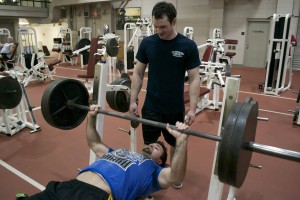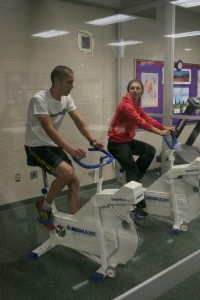The Exercise Fit and Special Populations, ES476, class is holding their third annual Exercise is Medicine Symposium to teach the community about special populations and the exercise they require.
Scott Drum, associate professor in the school of health and human performance, is the professor of ES476. Drum said the class focuses on special populations such as individuals with cancer, Parkinson’s disease, obesity and even pregnant women. Through the class, the students learn more about the condition, how to modify exercise and training for the special populations and how it benefits them.
“In the end, how does it help improve quality of life, improve one’s general happiness or outlook then, in particular, improving specifically muscle strength and endurance,” Drum said.
The presentation starts at 7 a.m. Wednesday, Dec. 3 in the Mead Auditorium. The session will begin with a lecture about Alzheimer’s and exercise. Each topic should lasts approximately 20 to 30 minutes followed by a question and answer session about each topic.
The special topics of the symposium were chosen by students and include the topics of Alzheimer’s, back pain, cancer, older population and falls, anxiety and depression, cardiovascular problems, childhood obesity, older adults, female athletes, osteoarthritis, paraplegic athletes and chronic obstructive pulmonary disease.
Tyler LaPlaunt, a second year master’s student in exercise science, said he believes the lecture helps people realize the many conditions that people face worldwide.
“I feel the lecture helps us realize that there are many people in this world with many conditions,” LaPlaunt said. “We incorporate our knowledge of exercise and the human body and find appropriate combinations of exercises that will enhance qualities of daily living and functionality for people affected by each disease.”
Megan Bondar, a first year master’s student in exercise science, said she believes it helps spread importance of exercise to medical practices.
“I feel it is important to adopt the principle of exercise as medicine in all fields of health care,” Bondar said. “I believe that this lecture will help spread the importance of this topic.”
Drum has held this event in recent years as a way to see what the students have learned from their own research.
“This was designed to force them out of their comfort zone and actually at the end have them feel like their mini experts on their topic,” Drum said. “Usually that means getting them outside of the classroom, inviting the public and putting them on the spot rather than if they’re just giving a normal presentation to the class. There is no real anxiety and they’re not as accountable that way.”
Though junior exercise science major Hannah Boyer said she does not believe her topic, childhood obesity, will significantly help her with future plans, she still believes it is a worthwhile experience.
 “It is always good practice to do research and learn how to present and do public speeches,” Boyer said. “A lot of the students presenting plan to do exercise physiology research in the future so it applies directly to what they will be doing.”
“It is always good practice to do research and learn how to present and do public speeches,” Boyer said. “A lot of the students presenting plan to do exercise physiology research in the future so it applies directly to what they will be doing.”
LaPlaunt urges all to come and listen to any of the presentations to see if anything jumps out as an interest.
“Find what interests you, maybe something that affects a family member, and try to learn a bit about the disease, about ways to intervene and use exercise as medicine,” LaPlaunt said. “With growing health care costs and a society that constantly pushes medication, give us a shot to teach you something different for a healthy change.”
The lecture starts at 7 a.m. and goes until 6 p.m. in the Mead Auditorium in the West Science building.





























